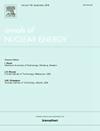Numerical study on flow instability development of natural circulation in narrow channel under medium-to-high pressure
IF 1.9
3区 工程技术
Q1 NUCLEAR SCIENCE & TECHNOLOGY
引用次数: 0
Abstract
Natural circulation flow instability is an important phenomenon for nuclear system safety, especially in narrow channels which have a broad application prospect. However, the small gap of narrow channels can easily lead to the narrow-space effect, resulting in mechanisms and performance of instability different from those in conventional channels. Medium-to-high pressure is a common condition in nuclear systems. Therefore, it is necessary to study flow instability in narrow channels under medium-to-high pressure. The ultimate goal is to effectively avoid the instability and improve the safety of nuclear systems. This manuscript investigates the characteristics of natural circulation instability in a narrow channel with deionized water under medium-to-high pressure (7.0 MPa-15.0 MPa). Results provide new insights into the safety and reliability of nuclear reactor cooling systems, supporting the establishment of more accurate and reliable natural circulation systems. A numerical study establishes a model of natural circulation loop including a narrow channel via system code RELAP5 based on a well-validated natural circulation test facility. The instability development is divided into three stages, natural circulation stable flow, instability flow (no reverse flow), and instability flow (reverse flow) or periodic dryout instability, according to the amplitudes and periods of mass flow rate. The proposed RELAP5 model demonstrates the relationship between mass flow rate and pressure drop on a time scale of a few seconds in every stage. Mass flow rate, exit quality, two-phase length, and flow regime are examined throughout all stages. Results indicate that increasing system pressure and inlet subcooling have a significant inhibitory effect on instability oscillation.
求助全文
约1分钟内获得全文
求助全文
来源期刊

Annals of Nuclear Energy
工程技术-核科学技术
CiteScore
4.30
自引率
21.10%
发文量
632
审稿时长
7.3 months
期刊介绍:
Annals of Nuclear Energy provides an international medium for the communication of original research, ideas and developments in all areas of the field of nuclear energy science and technology. Its scope embraces nuclear fuel reserves, fuel cycles and cost, materials, processing, system and component technology (fission only), design and optimization, direct conversion of nuclear energy sources, environmental control, reactor physics, heat transfer and fluid dynamics, structural analysis, fuel management, future developments, nuclear fuel and safety, nuclear aerosol, neutron physics, computer technology (both software and hardware), risk assessment, radioactive waste disposal and reactor thermal hydraulics. Papers submitted to Annals need to demonstrate a clear link to nuclear power generation/nuclear engineering. Papers which deal with pure nuclear physics, pure health physics, imaging, or attenuation and shielding properties of concretes and various geological materials are not within the scope of the journal. Also, papers that deal with policy or economics are not within the scope of the journal.
 求助内容:
求助内容: 应助结果提醒方式:
应助结果提醒方式:


